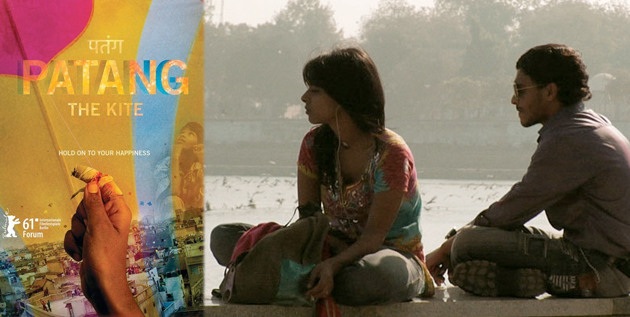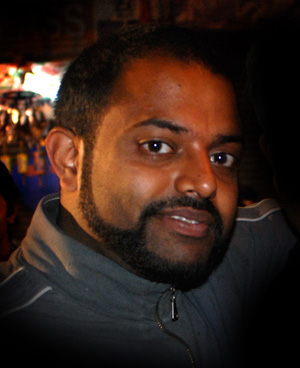 While at the Vancouver International Film Festival this year, I had the pleasure of speaking to the writer/director of Patang [The Kite], Prashant Bhargava. A Chicago-born filmmaker of Indian descent, his first feature length work has hit screens in Berlin and Tribeca before making its way to Canada, picking up praise at every screening. A very human tale of a family in Ahmedabad rekindling during the city’s famous kite festival, Bhargava’s film will enchant and intrigue through its exotic locale and very familiar emotions. Speaking about his process, the casts’ performances, and the crowdsourcing release soon to roll out, the following interview touches on personal style and the future of cinema itself. My review of the film can also be read here.
While at the Vancouver International Film Festival this year, I had the pleasure of speaking to the writer/director of Patang [The Kite], Prashant Bhargava. A Chicago-born filmmaker of Indian descent, his first feature length work has hit screens in Berlin and Tribeca before making its way to Canada, picking up praise at every screening. A very human tale of a family in Ahmedabad rekindling during the city’s famous kite festival, Bhargava’s film will enchant and intrigue through its exotic locale and very familiar emotions. Speaking about his process, the casts’ performances, and the crowdsourcing release soon to roll out, the following interview touches on personal style and the future of cinema itself. My review of the film can also be read here.
—
The Film Stage: Having seen your short film [Sangam] and now [Patang], there seems to be this theme of clashing perspectives—someone dreaming for progression and another person wanting to escape back to simplicity. Do you have that wrestling inside you with your American upbringing and Indian heritage?
Prashant Bhargava: Yes. I think in each piece it was a little bit different. The first was very much about longing for something and that was something that took place in real life—that interaction that I had—and then I brought in the notion of the rivers and stuff. But it was an exact conversation that I had before.
Then, after [Sangam], I wanted to make something more about immediate joy. It is very interesting because if you look at others from Bombay or New Delhi—the independent filmmakers—they don’t explore these themes. […] It’s definitely an Indian film in the terms of how it captures things, but those things that I find very interesting, in terms of the magic of the everyday, the power of family, the spirit that you feel in the kite festival, it is probably something that I missed in my own life. And you make a film in some way because it is your own therapy in a way.
I would say, yes, very much so. But I would also say—by making these two films—I have grown and I don’t feel I have those issues inside anymore. But I think I was as much connected to Chakku or Hamid as I was to Jayesh and Priya. Each character has a little bit of something that I wrestle with. As a whole, you have this landscape of people that are seemingly unrelated to you, but at the same time they are elements of you.
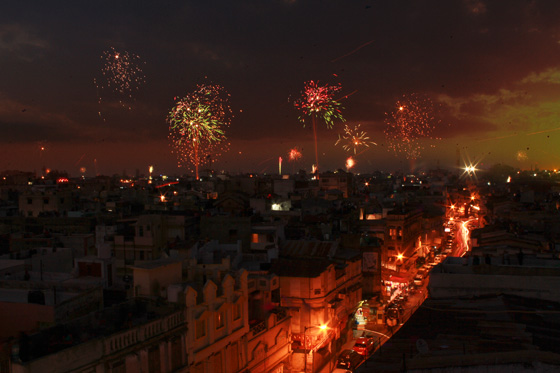
In that respect, fleshing it out for three years [in Ahmedabad], how much of the story did you have beforehand? Or did it all kind of happen naturally?
It was a story of a girl—a very simple one, maybe two characters or something […] originally. But when I went there and I saw this kite festival, it was so exuberant and affected so many people. You could see that there was a general kind of similarity in terms of the opening of spirit. It’s known as the ‘day the wind changes direction’—Makar Sankranti or Uttarayan. They call it Uttarayan in Ahmedabad, but Makar Sankranti in the rest of India. It’s a seasonal holiday.
And every festival that I’ve experienced, [the] people around me [and I see] something magical happening. You can’t predict when during the day or how, but there is a kind of change in perspective that happens. And so I felt I should reflect that in all these different characters, in their journeys and how it impacts.
I remember, for example, Chakku. The way that I came up with that character, I was at a family wedding […] and there was this wedding singer there and he was chewing on tobacco and spitting—kind of a disgruntled guy. But when he was on the mic it was beautiful. No one gave a shit about him. […] He was leading the band; he could just control everybody. And I just put the camera on him for maybe ten minutes and was just taping him. That became the character study, the storyboard for how we actually filmed it and was the information I provided Chakku [played by Nawazuddin Siddiqui] more than even the script. I was like, “Take a look at this guy.” Then I had him go and discover that person.
Hamid [Hamid Shaikh], for example, I remember I was walking one time and I saw this kid run after a kite. He almost got it—and this bike ran into him. And in India, when that happens, it’s not about the kid. The bike guy got off, slapped him around, and pushed him down. Said, “What’s wrong with you?” And it was such a look of hurt. Then this kid stands up—the bike goes away—and he still runs and gets that kite. And that was Hamid to me.
Sudha [Seema Biswas] was very much like the spirit of my mother in terms of that nurturing, that matriarchal kind of power of keeping together family. The grandmother is very much my grandmother because, you know, [she’s] someone who’s pious and at the same time very opinionated and also sly in her own way.
Jayesh [Mukkund Shukla] was one of my uncles, I remember—a combination of a couple. And Bobby [Aakash Maheriya] was just all the guys that I’ve met. But there was something about him, which was for me very familiar in terms of having that passion of craft and also that [naivety] in terms of interacting with women and all.
And I’d say, yeah, Priya [Sugandha Garg] is based on a couple of girlfriends. [laughter]
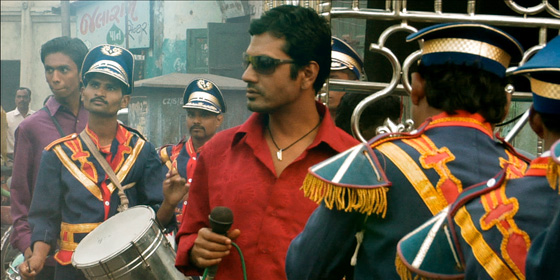
Going back to Chakku, the way you’re talking about how this guy would have this presence, did you ever think to have him sing again for his uncle or was it always kind of intrinsically known that he can, we don’t have to actually see it?
I mean, during the wedding, what we did was—[Siddiqui] wasn’t a singer. So I actually had him go through singing training with this local musician […] and he did a great job with it. And then I paired him up with one of these really shitty wedding bands—they sound awful, but they’re very authentic. And so he spent two weeks with them, just chilling with them and getting to know them, and finally they got a wedding offer. And the wedding was like, “Yeah, you can tape whatever.”
The tracks that are on there is actually him singing. It’s just very—when you edit and edit and edit it becomes shorter and then it comes to that point of what is it about? If it’s more his attitude and feeling in control and how he ran it then actually seeing that singing more often. And I liked how, later on, when he is challenged to sing with his uncle and then also in that lunch, he just won’t do it.
The whole film, there’s a lot out of the frame that you leave the audience …
Yeah, and you definitely feel that tension. In fact, I think I liked him the most, just because he puts on this tough exterior, but he’s out there with the kids and he cares and he’s having fun—his own kind of fun.
It’s the same thing with Priya. Her father has all these wants and needs for what she does growing up, but she goes out there with her camera and just kind of tries to embrace Ahmedabad even though he’s trying to pull her back. Was that a big thing, to show that dynamic?
Yeah, I mean, it’s implied that Jayesh doesn’t get on with his wife very well; that he and Priya also don’t spend a lot of time together. So there’s kind of this dysfunctional family there. At the same time he’s sort of made it in his own mind. And for Priya not to have the kind of connection to family—Bobby eventually tells her, “Have you ever had your friend’s mother feed you with her own hands.” That kind of warmth, she hasn’t had from her parents. And, ironically, she gets it from her aunt. That exact thing he was asking is the thing that her aunt was offering her.
She just hasn’t had that sense of family and it’s a common thing now when you see the breakdown of the family unit in comparison. And when there is a family unit, there’s a lot of expectations and oppression that happen. Even Jayesh, when he was coming up—for him he was always doing good. He made it and he wanted to change the family business and do all of that, but he wasn’t able to. They didn’t want to hear it. And now Priya and him are having a similar kind of tug-of-war.
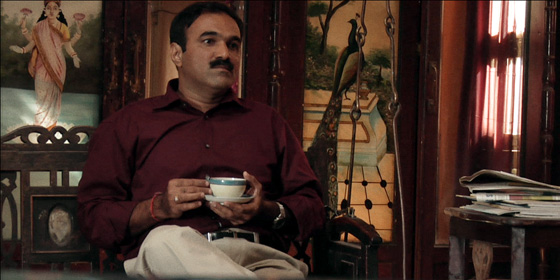
Could you talk more about—I know you were saying in the Q&A yesterday—you filming with your cinematographer? Did you storyboard or was it all kind of done in the editing room?
Like I said about Chakku and the wedding—I spent like eight hours in the kite-making shop, a day in the electronic shop, I found two people that were just flirting, I shot them. Much of the film, the prior year—my third year of research—I went out and found those real people experiencing it and shot them. And then I cut together about a twenty-five minute reel, which was very black and white—just DV footage—and that was my storyboard. So it was just generally a sensibility and setting up a few constraints.
When we were together and doing really well—myself and Shanker [Raman, the cinematographer]—it was like dancing. We were actors in this thing and we kept the crew very, very small. So it was just a few people and I would talk to him more like an actor then I would as a cinematographer, getting him connected to the things. And that’s how we would work together.
[There] were very long takes and it drove the crew mad. Especially the sound guys cause—“Why are you doing an hour-long take for a two-minute scene?” But the things you get out of that are just amazing. That’s how we would work and we shot two hundred hours of footage and I edited myself for two years [before] working with Joe Klotz, who edited Precious and Junebug. He helped me bring down a two and a half hour cut to size.
But it was very, very hard because you’re getting such magic, but the majority of the time you don’t have the proper coverage. [Speaking to me] If we’re talking, I don’t have an over-the-shoulder one-way or the other way usually. [With] Jayesh and Chakku I did. We shot it that way, but the majority of stuff I didn’t have that. So every scene was kind of pulling some magic trick to make it happen.
You know, you read these kinds of editing books by Walter Murch and there’s some great trick he did. I can tell you—amazing tricks, every scene had to be like a trick. It’s very much preserving the environment as it was, using long lenses for the intimacy but also because there is so much happening all over. Everywhere there is another story. If you kind of pull back you see a—you pull back on a street, you’re going to have twenty stories happening. You can’t do that wideshot. You don’t have that kind of single focus.
[…] And then as I’m shooting, you know—I don’t think I’ll shoot another film myself—but as a director, you’re like, “Oh, he’s doing alright. Okay, how are they doing?” So you get this intimacy there. There [are] a lot of long lenses and trying to really stay connected to people. And those very small kind of gestures or things that they go through were as revealing to me—like, if you have a guy crossing the street and he’s with his sister and she gets hit or something, that normal high amplitude tragedy, you’ve got a scene there. But also, if that guy walks across the street and for a moment he looks off and thinks something and then keeps walking—that can be just as revealing about him. And that’s what excited me. Not going to the highest kind of amplitude, but all that space in the middle and how much we can—if we invest a little into the experience we can see and feel a lot of those things.
[Patang] definitely has that authenticity to it when you watch. With so many non-actors, did you do multiple takes? I know, with Bobby, that very nuanced exchange at the end with Priya—was that just all one thing?
I would always pair an actor with a non-actor because then you have someone that’s always aware and guiding the scene. But they’re also required to be far more natural, because if they’re acting, the other person is like, “What are you doing?” So it kind of improves both parties.
For Bobby and Priya, in that scene, it was probably one of the first scenes that we shot. […] That first kiss, for example, that was the first scene that we shot with him. And we were on the rooftop and he didn’t know what was going to happen. Priya knew. I have them playing thumb wars and dance together and do all sorts of little exercises to kind of get familiar and get that flirtatious energy going. Then at some point she knew it and I knew it and she just goes over and does it. And that look—that expression …
Now later on, what happened probably two weeks afterwards—after that kiss—he genuinely fell in love with her. You know, she’s a big city girl and she’s married and all of that, so there was no real interest. It was all acting. It was work. But for him it was like, “Wow, I’m in love”. So that ending take was so charged with everything happening—I mean, she was angry that he was knocking at her door at two in the morning in reality. That was a forty-minute take. If I were to show you that whole forty minutes it would be stunning too. I cut it down to three minutes, that one take. That was probably one of the takes in the whole film where I was like, “Oh, man”. It was just magic.
Then I tried to do it a few more times, almost to the irritation of the actors eventually. Because I kept pushing it, trying to see if anything else was going to happen. So, that break-up scene I ran two times after that. But that first time was it.
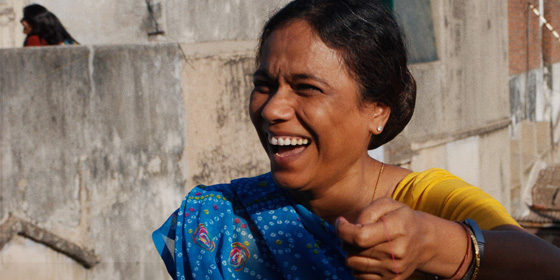
What has [non-actors] Aakash’s and Mukkund’s impressions been after seeing the film?
Both of them being from that area—I was most nervous for their approval in a way. Both are very—they feel like it’s their story. It’s their thing.
[Aakash] is as obsessed about kite flying as he is in the film. He stays up ‘til three tying his kite the night before and wakes up at five. They fly for two days actually and he is just consistently flying it—one of the best I’ve seen. Mukkund is a local politician from that area now and is involved in other things. They’re very proud walking around.
Aakash came to Berlin [Film Festival] and it was his first time out of the country. I took him to a nightclub, got all the girls to kiss him on the cheek—he turned red. And Mukkund now is coming to the Chicago Film Festival, so I’m really excited to have him there.
To see your home and experience that?
Yeah.
So, this naturalistic style—do you think with your new film—is that something you embrace? Or do you think you’re finished with that now to go into something different?
I’m just much more efficient. I’m not going to shoot two hundred hours of footage. I’m not going to take seven years. I will run standard scenes and be a little bit more conservative with the camerawork in terms of movement. At the same time, I know my spots and it’s incredibly effective.
For someone like me to do this film first is a treasured opportunity as I was able to do whatever I felt. I broke every rule. Now when you do that, it’s your voice. I think it’s very important for a first-time filmmaker—feature filmmaker—to put their voice down. And not say, “If I do this then I do that and then I’ll do that.” So I sorted a lot out.
The things I will certainly preserve in all the films that I make is—whomever I’m working with, they feel proud of the film. It’s their story. Whatever’s happening onscreen—it’s being lived and not acted. And the power of community—you bring together a community and represent them onscreen. Those are the things that if I were to do something in Chicago or somewhere else, I’m absolutely going to do those things.
Now, in terms of what I may change—just looking at the marketability and the wider appeal of a product. Maybe be a little bit more conventional in my structure and get more drama, a little poppier dialogue. Do that, but treat it how I treated this. Because that’s been crazy, seeing how the business works afterwards.
Yesterday you were talking about getting involved with Ahmedabad and releasing it there and kind of driving tourism in. I know when I was there in May, it was very different than all the other cities. We didn’t go in the old part, but I know it’s the fastest growing city in the country and there was this greater feeling of home. There were no beggars on the street—it was the only city we went to that didn’t have that—and it is this unique capsule. Do you see this film maybe giving more exposure to it?
The old city in particular is—you got to go back and see it—it’s a place that runs on a sense of faith. People would trust you before they mistrust you. But they’re very, very perceptive and very observant. So the more you’re in a good state of mind, the more good things will happen.
I think that the general conception of Gujaratis is if they show the new city off to everybody and their new lake development and the riverfront—that’s what people want to see. But for people like us, what’s most important is to feel that generosity, that humanity of the place. And that kite festival is a great example of what Ahmedabad really is. For all of us to go there and take interest and eventually invest business-wise or settle down there, that’s more important than, “Oh, they have a great new skyscraper”.
So, that’s an interesting kind of thing to push to the government in order to have people understand that. The Tourism Department.

Are the actors willing to help with that? Is it a goal of theirs as well?
Oh yeah. As a filmmaker you come to a point where it’s like—all of the people who invested money in this film hope to get a return. But that wasn’t their main purpose. They all invested amounts for them—they can lose it. It was that kind of investment package.
So, as a filmmaker you’re going to do everything you can to get it out in the traditional routes and generate the money back and do well, but I think [it’s] more important to me now [to get] more people to see it. And whatever way this can change or impact the world and create a different perception of Ahmedabad, that’s very important to me because film is India’s best brand ambassador. You watch Slumdog [Millionaire] and that’s what people know about India. So, that’s great, but there’s a lot more humanity and a lot more universality in family and all of that. It’s not something you can look at, it’s something that we can all feel, that there are ties we can all have with them. So I think that’s very important.
I think it comes through a lot, even little details like when the cow is coming and [Bobby] kind of pushes Priya out of the way. Because that was happening while we were walking through the streets. It’s random, but it’s beautiful—it definitely comes through in the film. It’s very nice.
Speaking of the investing, I know you were saying yesterday that you’re doing an alternative release. Could you speak a little bit about that?
Yeah. We’re about to begin an IndieGoGo campaign to do some crowdsourcing to fund a lot of the—still the traditional routes are being explored and we’re having some possibilities with that, but we’d also like to do a very grassroots release in Ahmedabad. And we’ve had great success in New York, and Chicago is selling out right now.
So, Ahmedabad, Chicago, New York, San Francisco might be a possibility, [Los Angeles], and Bombay. For those areas, I think a film like this cannot simply rely upon the traditional advertising routes, the traditional distribution routes. You have to be creative and identify your audience rather than sit back and say it’s for this demographic, because it doesn’t work that way—now especially.
In Ahmedabad, I feel like if you look at Jay-Z and “Empire State of Mind”—that track with Alicia Keys—that became an anthem for New York. And from there it just blew up. I feel that this movie can be an anthem of Ahmedabad, especially a lot of the songs. Maybe next year or the year after, whenever it’s there, people are going to be pumping it in their radios, that Ahmedabad song that’s there. So, if I can spark that in Ahmedabad—
And that involves traditional things of getting your billboards up and music videos done and getting your ads and all of that, but also involves something like— I have a guy […] who’s worked with me for years. He’s a newspaper guy who basically distributes the newspapers and in the morning he’ll take all these ads that people have given him and insert them into the paper. Now that is as important to the marketing as it is in the other way. Or if every rickshaw—I think with 3 Idiots or Ragini MMS, they had things on every rickshaw about the film and that was great advertising. I feel like if I give ten thousand stickers to all my kids in the film, they’ll go crazy and get them up everywhere. That’s just as important and I think you have to choose.
I’m not saying the audience is only Ahmedabad, but if I light the fire there and Ahmedabad says this is my movie, then it can go elsewhere. So if you can get that 20-40 demographic feeling very excited about the film, then once a parent sees it—because the parent loving it isn’t going to be able to bring the kid. […] If I were to say whom does it appeal to, I think it can appeal as much to a grandmother as it can to a ten-year old and someone who is in America or in India. German audiences have loved it, and Italy and Mexico. So I’m finding that it’s rather universal in different ways. There’s different ways that they relate to it. But I think a good way is to spark it is in Ahmedabad.
And go from there.
So, for that, what does that mean? We have to get these music videos edited and get some more promotional materials that are geared toward that sort of thing. Just traveling there, setting up a team—a kind of strategy team […] working with the other traditional routes. It will take another two or three months of effort and collaboration.
We’re out of money, so that’s what we are hoping to do with the IndieGoGo campaign.
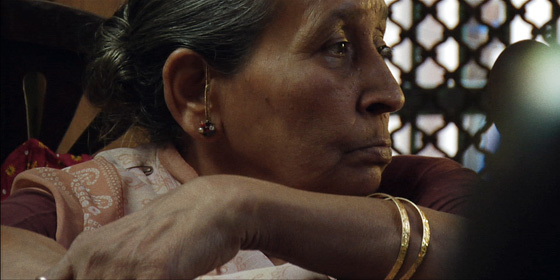
I know—being from America—it seems Bollywood has this stigma and advertising this as the counter-product to that could definitely give it more exposure there. Do you see audiences in India being enamored by it?
Yeah. I feel like I have to pay attention to what sells a film there, which is music. Music videos [are] what bring people into the theatres.
So, if you looked at a recent success of a semi-independent film there, Delhi Belly, half of their music videos have nothing to do with the film. At some point—many years ago—they would just take an excerpt of the film and show that song on the tv. Now they’ve become music video trailers. So those are very important, I feel. To make them very hype, kind of compete against the excitement of a Bollywood film in a raw, energetic, true way to this film, but not ignore that. And if I can get hits on YouTube from a video when that song is playing, I can get people in the theatre.
I think this is not a film for everyone. It’s definitely something that when an Indian sees it that’s accustomed to Bollywood, it’s out of left field for them. But I do feel that the country is so big and there’s so much great movement happening in terms of independent voices and people are craving new things that this can do well.
And would you—I know with your background—plan on cutting those things yourself?
Yeah, I’ll cut them.
I think with the posters—I made the two posters that we have now; I collaborated on one of them. I might art direct a bunch of guys doing the posters. I think now a little bit of different perspective [is necessary] at this marketing thing—because I’ve been with it so long. I can do a poster for someone else quickly [laughter], but for myself it becomes an agonizing experience.
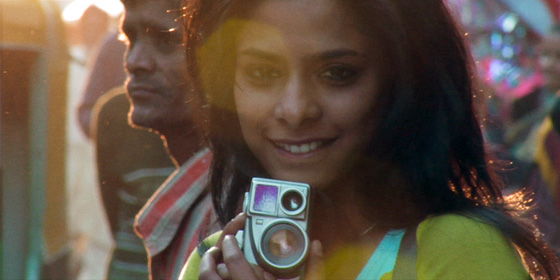
You’ve brought a lot of that experience into the film. There are cuts and stuff in the first half, but when the kite flying starts there is that moment where it just gets kinetic and really beautiful to look at.
I began in motion design work, doing a lot of trailers and promos. I packaged “The Wire” and “Def Poetry Jam” and “Rome” and [have] done about a hundred projects for HBO and many other clients and you’re working in a very small timeframe. When I began doing that stuff, probably in ’95, I would layer things very intensely and that became what I was known for for some years—this kind of layered, textured, crazy stuff. And I started in graffiti, so the way I cut a letter when I was a kid tagging up to the way that I’m putting together textures in terms of color contrasts and rhythm is reflected in the way that this film is constructed—in the terms of the editing and in terms of the camera and how one shot flows to the next one. There’s a lyricism to it and that comes more from my motion design and commercial background.
I love it sometimes, people critique it in terms of, “It’s too much” or “It’s self-indulgent”.
Then you look at a Tony Scott or someone and it’s not even a question—
Look at The Bourne Identity and how they’re cutting—
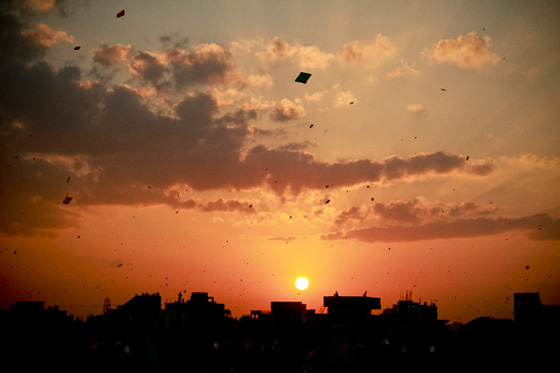
Yesterday you were talking about the Super 8 camera that Priya had and how you did a lot in post with that. Are you happier—you said originally you were doing it with another camera—
No, originally I just thought I might—I would say, “Oh, what’s the latest phone camera, latest camera that someone would use?” And I was happy we didn’t go in that direction because three years or two years [from now] when it’s finished, it’s a new camera and it would look like she’s in an older state of mind having that kind of thing. I think it also—there is a lot of interest from our generation to shoot in these non-digital ways. I love Super 8, that feeling of it. I also just wanted to make it her voice; how she sees the world and give it its own little flair.
Did you ever think of re-shooting it in actual Super 8?
I did that a lot in Sangam. For example, we had Super 8, Super 16. There was still photography, that stuff in the beginning was DV. Then I took Mylar and dripped glycerin on it and shot with a 16 camera through that and projected it to give it that real dream look.
I really enjoy that and when you’re doing a larger project—to mix the mediums in that way … now I’m at the point where it’s like, alright, I’m going to shoot on a standard medium with openness in terms of my tonal range so I can crush and play around later. Because when you shoot on Super 8, it’s such [an aesthetic], it takes you into another state of mind that it wasn’t quite what she was. So having this layering thing where there is reference to Super 8 and the flicker and adding some grain with it, there’s a lot of other weird things happening that it feels a little bit […] slicker. That was more her than it was Super 8.
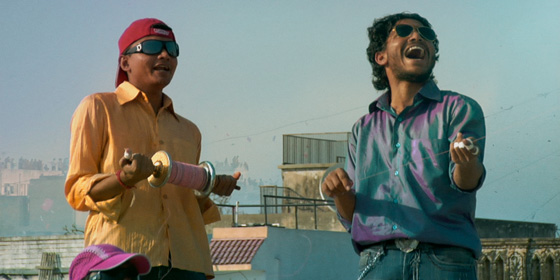
Speaking of Sangam, with its distribution through MUBI.com, do you see yourself embracing the more alternative routes or would you really like Patang to get a theatrical release?
I’m completely on the alternative routes, myself. Now, I’m the filmmaker and there are other parties involved—producers, executives, and salespeople and all of that. But I feel like—even on the next one—how do you leverage piracy to actually promote your film? […] You can be afraid someone is going to download your film—they’re going to download it.
For example, in the gaming world, at some point people would discover cheats in the game and that would be a big thing. Now they consistently build in cheats and in a month or two or six months they’ll release more cheats. So they’ve flipped it to actually embrace that notion.
Another crazy idea I’ve had—I haven’t talked to anyone about it—why not release just twenty minutes of the film? Put it out there. Now if I do that, they’ll want to see the rest of it. Also, with songs, the next one that I’m thinking is if I have some song sequences—release them as music videos with great artists. Almost fund the film through those tracks. You’re not releasing it during the completion; you’ll release them as time goes on and build a community around that.
So I think as filmmakers the world is different. It’s no longer going to go back. Netflix and all these guys are running monopoly. They can get your things for ten grand—very small amounts of money—and your DVD sales are going down. Theatrical [releases] for films this size is an event more than it is a moneymaking thing. In that kind of context you have to say, “Alright, this it what it is—now what?”
After I finished this film—this realization’s only recent—I would say I was enamored by the idea that it would release at the BAM cinemas or an Angelika or Sunshine in New York and then I’ll get those write-ups. It’d be a Wong Kar Wai kind of success or something like that … and it didn’t happen. This wasn’t a film that caught on […] and when you look at the films that do, they’re good but they’re usually conventionally structured and they’re very timely. They just hit what people want now. And that’s a bet—how do you predict that?
I’m proud of what I’ve done and I’ve got to get it out regardless. So, how do you do it?
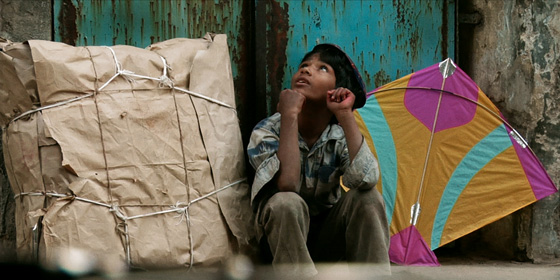
Do you think that puts you ahead of the curve of people coming out now with films—to be able to embrace that? Do you think a lot of people are now?
A lot of people are, but I feel those people who are genuinely embracing [it] are known for that. They’re leveraging social media and talking more about the social media than they do about the film. So there’s so much talk about it—Ted Hope and all of that—but I don’t hear them talking about great films as much, just all these new ideas about how to get it out there.
It still has to be content-driven. You still have to make and put your love into it. But you have to embrace all these things in how you cultivate the project from the beginning and how you put it out there. But it’s still about the film, still about what you’re doing. To have these filmmakers’ discussions where you’re all talking about these great crowdsourcing or alternative releases—you’re not talking about your craft anymore. I think it’s kind of stupid.
So it’s important for me to find a structure […] to do what I enjoy doing and get my voice out there, but embrace it all. And that’s equal on the other side. Meaning, if you look at it from a conventional distribution—what types of films sell? Right now from the foreign market: genre films. If you want to do Bollywood films you have to go to the masses. One guy against the world and some crazy thing happens—[you] have a certain style of acting or if you want to do the Indian film that is successful internationally you have to show the poverty and the tragedy and some grotesque thing that happened. […] Now do I pitch a film that is entirely along those lines?
There are people who are obsessed with that too. “What’s your budget? Oh, it’s not a superhero film?” And they’ll shut it down. It’s happening on either end. It’s very important to embrace those things that determine the success of the film—be conscious of them, structure your piece within that—but as a filmmaker it’s also very important not to be driven entirely by that. You have to be driven by what you do and that very personal voice or whatever in your films. You can’t go simply to the traditional distributors and think what they’re saying is great or to the crowdsourcing people and say we’ll do well there. And what has done well—I have to do that. You have to say, “This is the landscape. How can I use all these things, but stay connected?”
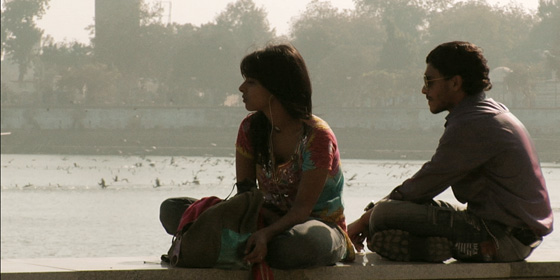
And you said you were going to the Chicago International Film Festival next—any others on the horizon?
Yeah, we’re going to Mill Valley a day after tomorrow, which is a really nice one in San Francisco. Then Chicago International. Then there is a small one in DC—an Asian film festival. Then Hawaii, Geneva, Stockholm … so it’s continuing. A Hong Kong Asian, I think. I’ll be traveling a bit.
Do you like that aspect of it? Seeing new places?
It’s great meeting people; great learning how people respond to your film and seeing other people’s work. For me, after seven years of doing this, it’s good to breathe and do that. But at the same time I’m broke, have no job, no home, and no girl. I’m kind of craving that time when I can sit down and start working on regular life. I’ve put a lot of that on hold.
To learn more about Patang, visit the film’s website at www.patang.tv. And to help fund the release in Ahmedabad, visit IndieGoGo today.

